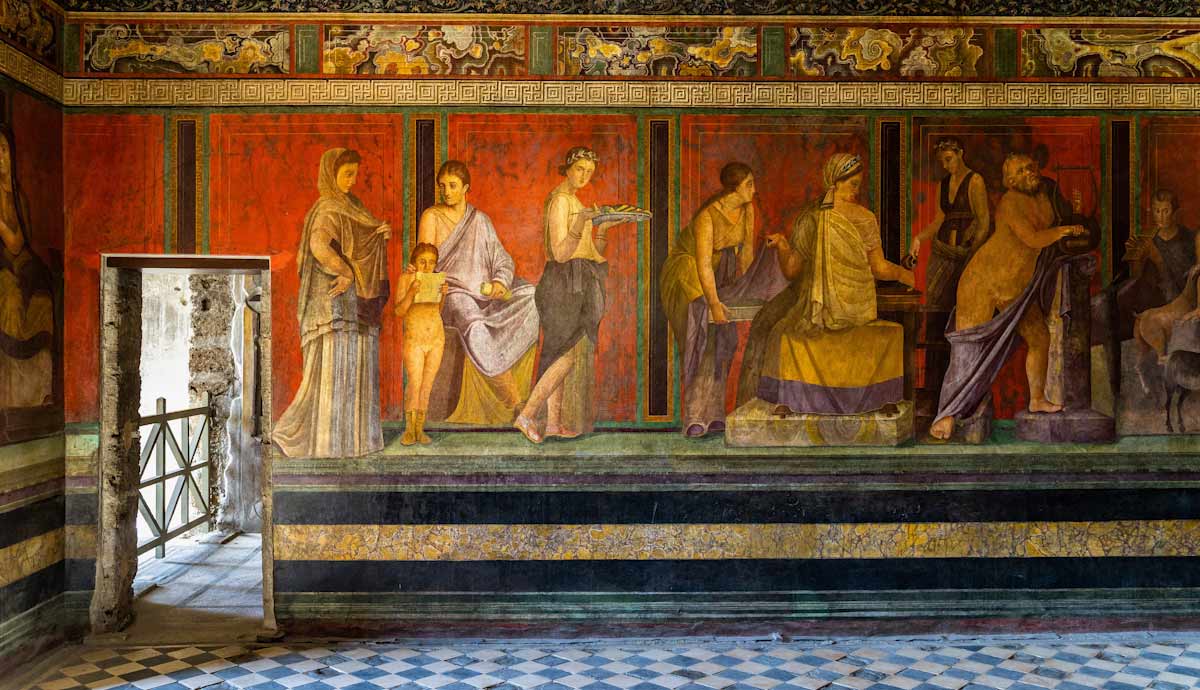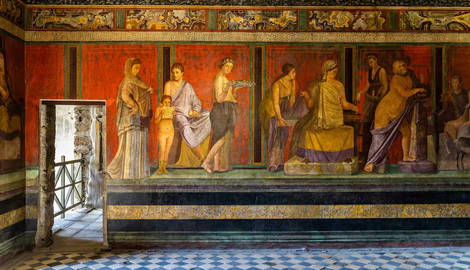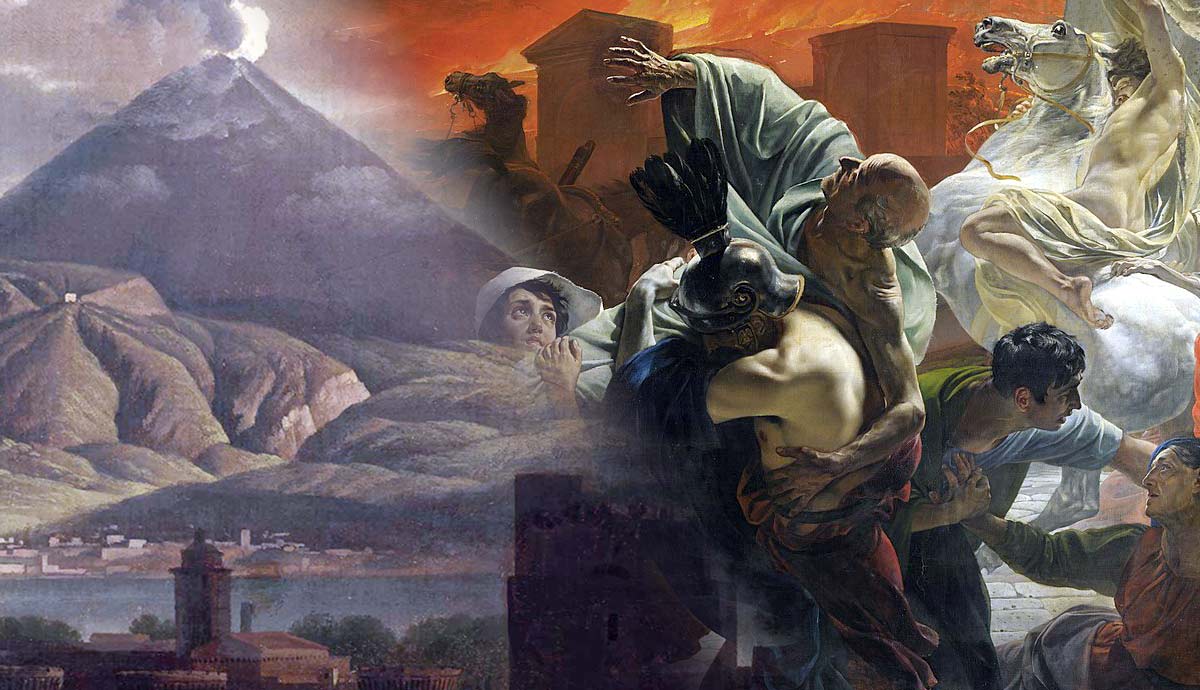
On the Bay of Naples in 79 CE, the catastrophic eruption of Mount Vesuvius destroyed Pompeii and the many towns, villages, and villas surrounding it. Buried beneath lapilli and ash, Pompeii lay dormant for almost 1,600 years before it was rediscovered. In the years since, archaeologists have been dedicated to uncovering the secrets below the soil and bringing the stories of the people who lived there back to life. But why is this ancient city still so important 2,000 years after it was destroyed?
The Rediscovery of Pompeii

Rumors whirled around for centuries that towns in the area local to Naples were buried by the volcano in ancient times, and ancient literary records from Pliny the Younger and Tacitus told the story of how this happened. However further eruptions, particularly in 471–473 and 512, covered any remains there might have been more deeply and the town of Pompeii fell into legend. But in the late sixteenth century, Domenico Fontana, while digging a water channel through Pompeii to make an underground aqueduct to serve the local area, discovered an ancient wall covered in inscriptions.
The shaft entered the entombed walled city north of the Sarno Gate, cut across via dell’Abbondanza in the vicinity of Insula II.5, and traversed the city close to via di Castricio and via del Tempio d’Iside (one block south of via dell’Abbondanza). Crossing the forum, it exited north of the Porta Marina. It was here that the diggers encountered buildings and wall paintings, but the discoveries did not stimulate further interest. Fontana decided to keep it a secret, and so it remained, until 1689 when Francesco Picchetti found a wall inscription mentioning decurio Pompeiis (“town councilor of Pompeii”).
However, instead of ascribing it to the ancient city of Pompeii mentioned in the ancient texts, he instead associated it with the villa of Pompey, the famous Roman general who lived around the same time as Julius Caesar in the late Republic. It was Francesco Bianchini who eventually pointed out the true meaning of the inscription. This was supported by Giuseppe Macrini, who in 1693 excavated some walls and wrote that Pompeii lay beneath La Civita
(the local legend of a buried ancient city). Work did not begin at Pompeii until 1748, and in 1763 an inscription (“Rei publicae Pompeianorum”) was discovered. This is what identified the site as Pompeii.
Early Excavations at Pompeii

Today, Pompeii is the longest continually excavated archaeological site in the world, and has provided historians with a glimpse into ancient life in an ordinary Roman town. This all began in the Roman period, during the reign of the Roman Emperor Severus Alexander (r.222-235 CE) when workers were ordered to uncover the town. However, they found that the thick layers of lapilli were virtually impenetrable and they abandoned the effort.
It was as a result of excavations at nearby Herculaneum that efforts to find Pompeii were begun in the 17th century. Previous to the eruption of Vesuvius, Pompeii originally lay 128 feet (39m) above sea level, on a prehistoric lava flow about 5 miles (8km) from the foot of Vesuvius. During the eruption, hot ash and gases (known as pyroclastic flows) traveled at speeds of up to 100mph (161 kph) into the towns in the surrounding area, knocking down buildings and killing all living beings in their wake.
The stages of the eruption, and the time of each, can be traced in the layers of material left behind. This has taught us much about the experience of the people living in the area of the time, as well as the reliability of ancient sources (such as Pliny the Younger who recorded the event), and volcanic eruptions more generally.
There were two main phases of Vesuvius’ eruption. These were called Vesuvian and Pelean, and alternated six times. The first released pumice, hot gases, and ash, with the pumice reaching up to the first floor in Pompeii. The Pelean phase consisted of pyroclastic flows, the ash solidifying all that remained in Pompeii. It was because of this final phase, and the exact weather conditions of the day, that Pompeii was preserved as it was for archaeologists to find centuries later. And it is this tragic, but serendipitous turn of events, which has made the town so special and important to history enthusiasts and archaeologists across the world.
How Early Excavations at Pompeii Changed History

When the first systematic excavations began in the 1700s, it was most akin to a treasure hunt. So-called excavators, working on behalf of King Charles III of Naples (known as Charles of Bourbon), were on the hunt for silver and gold, as well as marble statues, to sell and adorn the palaces. In addition to this, the excavations would enhance Charles’ international reputation and cement his position as head of a new ruling dynasty in Naples. Also at this time, Europe was entering a period of classical revival in terms of architecture and art, making the treasures found here sought-after items for the houses of the European elite.
The Grand Tour, a coming-of-age journey taken around Europe by royalty, writers, poets, and artists, was also getting into full swing during the time of the Bourbon excavations.
Soon, Pompeii was a ‘must-see’ on the Grand Tour itinerary, with many visitors recording their time at the site in words and images. Many of these are now excellent sources for historians wishing to reconstruct the early excavations and reception of the site. On the occasion that a particularly important dignitary would visit, sudden ‘discoveries’ would be made in the trenches, with the lucky visitor often taking home a memento of the discovery upon their departure.
The influence of Pompeii upon art, literature, poetry, and music was substantial during this time, and this fascination would continue to evolve over the years as excavations continued. In the nineteenth century, the slapdash treasure-hunting approach of the Bourbon excavations was abandoned in favor of order and record-keeping under the management of the new director, Giuseppe Fiorelli. It was Fiorelli who altered the view of Pompeii as a place of treasure to a place of stories and histories. Though not perfect, archaeologists and historians today are nonetheless indebted to his systematic note keeping during excavations, and the many things his team found there.
The Age of Amadeo Maiuri

As a Professor at the University of Naples, author of some 300 publications, archaeologist of one of the world’s most significant historical sites, and always impeccably dressed, Amadeo Maiuri left a legacy in Pompeii that cannot be ignored. In 1924, after some time working on various archaeological sites in Europe, Maiuri was installed as Director of the National Archaeological Museum in Naples, as well as Chief of the excavations at Pompeii and Herculaneum, and superintendent of antiquities for the region of Campania.
Maiuri and his teams exposed many new areas of the town and proposed chronologies in the history of the town which are still discussed in important scholarly debates today.
Excavations in a house previously discovered in 1770, the House of the Surgeon (so named due to the surgical equipment found here), were restarted in 1926 by his teams. This revealed levels below the 79 CE level (dating back to the third century BCE) and taught us much about the development of the town previous to the Roman period. During the war, he did much to protect the artifacts from ending up in the hands of Nazis during their regular pillaging of museums.
Many outputs of Pompeii have been positive, though the same cannot always be said of the influences involved in the town’s excavation. During World War II, Maiuri was subject to the fascist rule of his home country, Italy, and his work flourished under the patronage of the scheme. One key aspect of the Italian fascist regime was propaganda modeled on the classical theme of “romanità,” translated as the “Roman way or manner” and modeled on the Latin concept of romanitas. Maiuri was ultimately responsible for perpetuating the image of Pompeii as “frozen in time,” though this was ultimately communicated to support the image of technological progression, willpower, and hard work in the ‘New Italy’ created by Mussolini. Once again, Pompeii was an important factor in changing history in the modern world.
The Importance of Ongoing Finds at Pompeii

Maiuri restarted excavations after the delay of WWII, and from 1951 onwards uncovered large areas of the town to the south of the Via dell’Abbondanza, the town’s main street, in Regions I and II. All debris that had been left outside of the city up until this point was also removed, revealing the Nuceria Gate and a necropolis just outside of the walls. By the 1990s, about two-thirds of the city had been revealed.
In this time, two amphitheaters, hundreds of houses and shops, workshops, inns, stables, brothels, temples, gardens, vineyards, and baths were uncovered. In each, the frescoes painted by skilled workers, and the many artifacts left behind by former inhabitants, opened up a window onto an ancient civilization whose time was cut short. For the first time, archaeologists and historians had tangible evidence on a large scale for the ways of the ancients they had been reading about in the ancient texts for centuries.
In numerous buildings, the cavities left by the decayed remains of Vesuvius’ victims in the hardened ash, were filled with Plaster of Paris. As the hardened material was pulled away by excavators, the form of people living two thousand years ago was revealed to modern eyes, complete with the markings of clothes and shoes. Inside, their bones unlocked secrets about ancient nutrition, illness, and health, importantly taken from a population killed by a natural disaster, rather than natural causes.
Later, this technique was applied to plants, telling us much about the diets and occupations of the local population. Due to the long-term excavations at the site, almost all new technological advances have been tested in Pompeii, meaning that it has remained at the forefront of archaeological discovery. And the advances show no sign of stopping any time soon.










